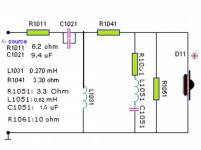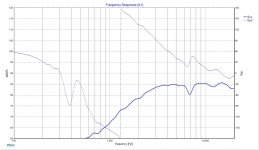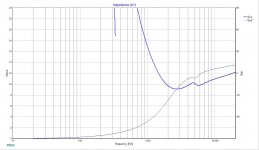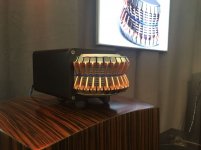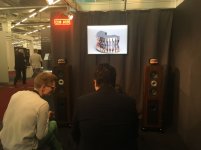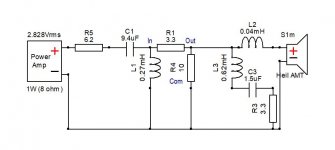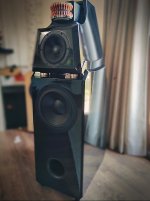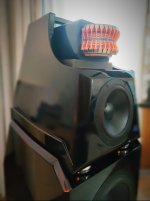Another option for those looking for crossover guidance. I eliminated most of the resistors because I may use this with some pro high-efficiency mids, and I changed to 3rd order to protect the tweeter from high power. Note the 3dB divisions in the graph - about +- 2dB from 2.8Khz - 16KHz. I have not measured this version yet.
Hello, thanks for the information. What is the function of the LCR circuit in your crossover?
Hi, as I said, only I have added the LRC circuit of your scheme. Currently the volume level of my ESS is adjusted to my taste in relation to the mid wofer and wofer. I do not know if it is necessary to use the same crossover T-Pad system that you proposes to get the same result from the crossover response simulation. I attach photo of my current crossover. The truth is that with the RLC circuit the "silabance" of the ESS is greatly softened. Maybe that problem is maintained (I place it now around 7-8khz) but it is much smaller than without the LRC circuit. I prefer the sound without the bovine of 0.05 uH. It's personal taste. I have to say that the problem of "silabance" is much greater when listening to compressed music, for example through youtube, than listening to music with my cd player. I am not able to explain the reason.Hi Toni,
If you desire more overall level from the Heil then make the R5 resistor smaller.
One only needs to parallel any value resistor to the existing R5 ( 1.5R ) to arrive at a smaller net value.
You might start by adding another 1.5R to R5 ( giving a 0.75R value ) to see if the increase in HF level is attractive.
Apart from the above, how does this custom setup currently sound to you ?
🙂
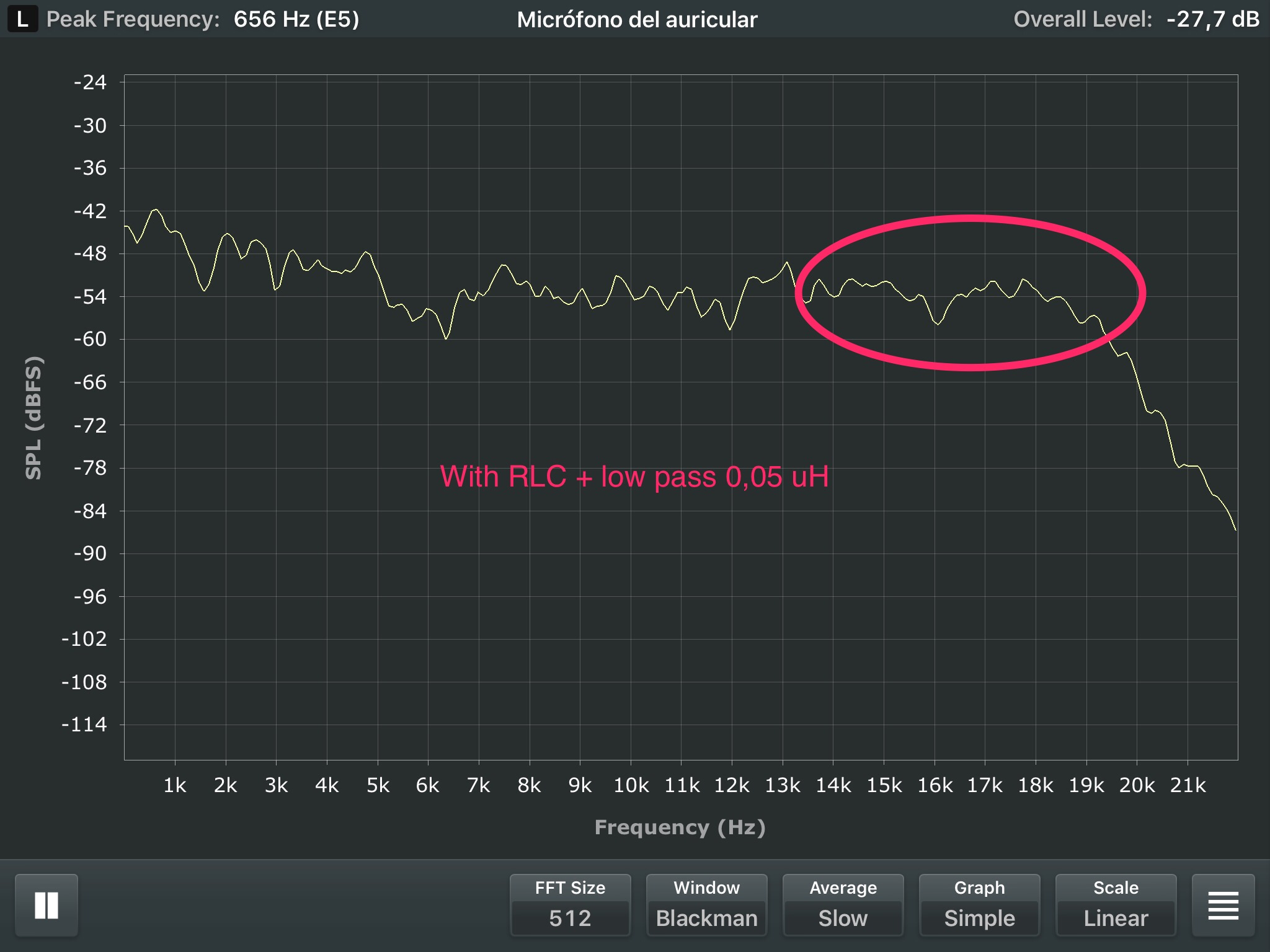
Thank you for you help
Br
Attachments
Hello, thanks for the information. What is the function of the LCR circuit in your crossover?
That is a broad, low Q "tank" - it flattens out the frequency response 3k-16k.
If you lower the resistor value, the Q goes up, and it will show a dip.
If you change the inductor or capacitor value, it will change the center frequency of the filter.
You can do these kind of filters either in parallel to the driver (as I have done), or you can use a LCR components in parallel, then place that group inline with the tweeter positive lead.
Hope this helps
TONI,
Here's a 2300hz HiPass for you to play with ( level will need to be adjusted to match your existing speaker > whatever that is ).
- 2300hz is @ 6db down from 4K.
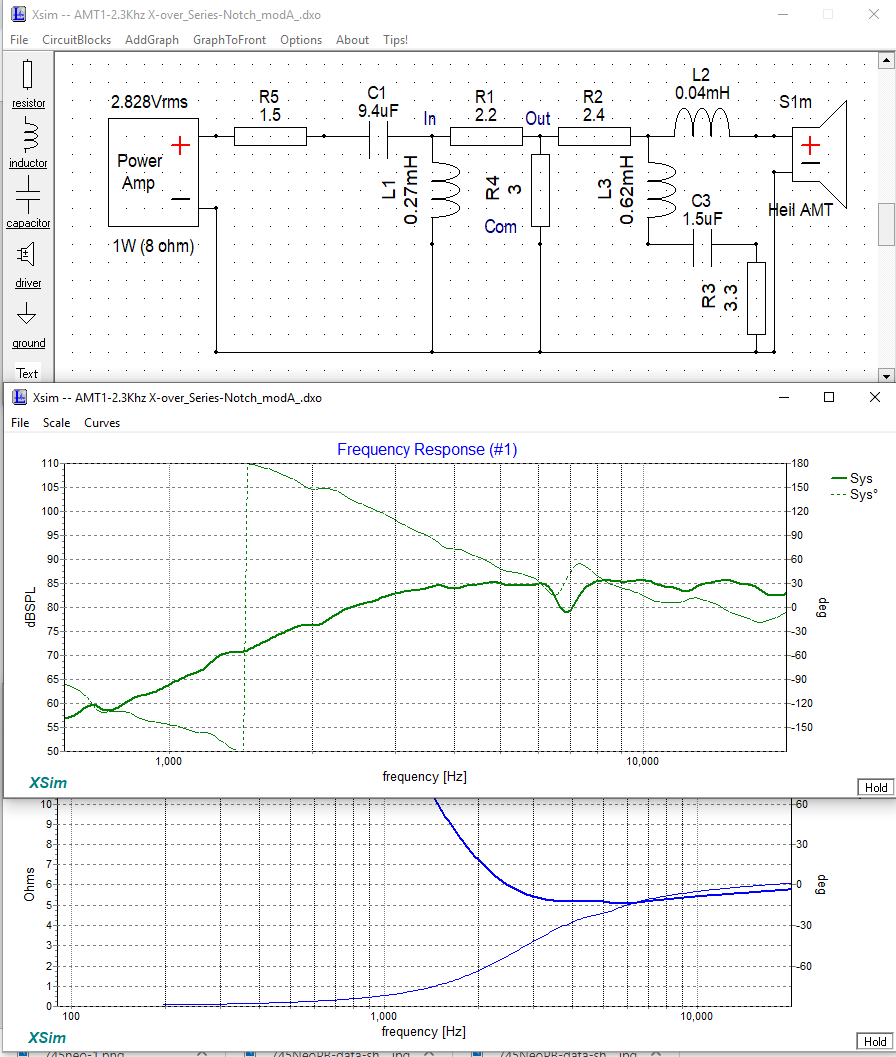
The .dxo file is included for those who wish to play.
- FRD + ZMA files were created using RobH's pics ( with a further 5db of attenuation added bringing the overall raw sensitivity to right around 100db ).
🙂
Hi, since I am a newbie in this forum, I have just discovered that the crossover simulation program is free to download in this forum. I will try to download it and learn how to use it.
On the other hand, I would like to know (in a general way) what effect it generates to modify the value of some of the components of the notch network (lower or raise the value of the resistance, the cap or the bovine).
Another question I have is if, by changing the high frequency loudspeaker (from a scan speak to the ESS) over the original design of the Troels ATS, it is necessary to recalculate the temporal alignment of the ESS in relation to the mid loudspeaker. The cut remains at 2300 Hz but I do not know if the peculiar characteristics of the ESS makes it necessary to calculate this parameter and, in consequently, to advance or delay its physical position in relation to the mid loudspeaker. It has caught my attention to see that many ESS are placed far behind in relation to other speakers.
BR
Hi Toni,
Acoustic Center ( of the AMT ) ?
Simply put, I believe you will find that the ESS/AMT device is found placed some distance back from the front edge of the baffle because that position offers the best phase match with the other components ( woofers or mids ).
I don't own any of these device but I imagine that the Acoustic Center is right there at the pleated ribbon.
LCR Notches?
The frequency were the notch occurs can be calculated with this formula.
1 / ( 2 * Pi * ( sq root of Capacitance * Inductance ) ).
Inductance is stated in Henries ( within the formula )
Capacitance is stated in Farads ( within the formula )
Many different values of Coils and Capacitors can be combined together to arrive at the same notch if frequency.
- What changes ( along with these different component choices ) is the "Q" ( or sharpness ) of the cut.
A notch alters it's Q ( sharpness ) as one applies more & more attenuation ( by lowering resistance ) making arriving at final component values a matter of "Trial & Error" ( as well as just being well practiced in the craft ).
I have to admit that I long ago gave up using math formulas ( for Q adjustment ) .
- Though one by-product of those past efforts was the use of "T" filters since they allow one to maintain a higher "loop-impedance" within the section of the filter that a series type notch is typically placed.
In practical terms when designing notches ( for the Audio bandwidth for 4 - 16 ohm speakers ) & for frequencies greater than 1000hz , I start by loading coil values of 2.5mH, 2mH, 1.5mH, 1mH, or 0.5mH ( into XSim ), then shorting the resistor icon and then adjusting the capacitor values ( up or down ) until the notch occurs at the frequency of interest.
Hopefully this is somewhat helpful ( since I'm not an EE teacher and I've only got one coffee in me ).
🙂
PS; the use of applied resistance, controls the depth of the notch.
Acoustic Center ( of the AMT ) ?
Simply put, I believe you will find that the ESS/AMT device is found placed some distance back from the front edge of the baffle because that position offers the best phase match with the other components ( woofers or mids ).
I don't own any of these device but I imagine that the Acoustic Center is right there at the pleated ribbon.
LCR Notches?
The frequency were the notch occurs can be calculated with this formula.
1 / ( 2 * Pi * ( sq root of Capacitance * Inductance ) ).
Inductance is stated in Henries ( within the formula )
Capacitance is stated in Farads ( within the formula )
Many different values of Coils and Capacitors can be combined together to arrive at the same notch if frequency.
- What changes ( along with these different component choices ) is the "Q" ( or sharpness ) of the cut.
A notch alters it's Q ( sharpness ) as one applies more & more attenuation ( by lowering resistance ) making arriving at final component values a matter of "Trial & Error" ( as well as just being well practiced in the craft ).
I have to admit that I long ago gave up using math formulas ( for Q adjustment ) .
- Though one by-product of those past efforts was the use of "T" filters since they allow one to maintain a higher "loop-impedance" within the section of the filter that a series type notch is typically placed.
In practical terms when designing notches ( for the Audio bandwidth for 4 - 16 ohm speakers ) & for frequencies greater than 1000hz , I start by loading coil values of 2.5mH, 2mH, 1.5mH, 1mH, or 0.5mH ( into XSim ), then shorting the resistor icon and then adjusting the capacitor values ( up or down ) until the notch occurs at the frequency of interest.
Hopefully this is somewhat helpful ( since I'm not an EE teacher and I've only got one coffee in me ).
🙂
PS; the use of applied resistance, controls the depth of the notch.
Last edited:
good morning, I am very happy with the XSim tool. By downloading the file shared by EarlK of the AMT, I have been able to include all the components of the current crossover. It is very interestingTONI,
Here's a 2300hz HiPass for you to play with ( level will need to be adjusted to match your existing speaker > whatever that is ).
- 2300hz is @ 6db down from 4K.

The .dxo file is included for those who wish to play.
- FRD + ZMA files were created using RobH's pics ( with a further 5db of attenuation added bringing the overall raw sensitivity to right around 100db ).
🙂
It has caught my attention when I compared the original crossover made by Earlk with the one I have that the answer is practically identical. However, the impedance graph and the slope of the fall of the response curve are very different. The only difference between both crossovers is the Lpad circuit. I use Duelund resistors and they are quite expensive. Do you think it is worthwhile to adjust the values of the earl ear design by changing the current resistances for which the EarlK design includes?
Thank you very much for the help.
Attachments
Hi Toni,
Acoustic Center ( of the AMT ) ?
Simply put, I believe you will find that the ESS/AMT device is found placed some distance back from the front edge of the baffle because that position offers the best phase match with the other components ( woofers or mids ).
I don't own any of these device but I imagine that the Acoustic Center is right there at the pleated ribbon.
LCR Notches?
The frequency were the notch occurs can be calculated with this formula.
1 / ( 2 * Pi * ( sq root of Capacitance * Inductance ) ).
Inductance is stated in Henries ( within the formula )
Capacitance is stated in Farads ( within the formula )
Many different values of Coils and Capacitors can be combined together to arrive at the same notch if frequency.
- What changes ( along with these different component choices ) is the "Q" ( or sharpness ) of the cut.
A notch alters it's Q ( sharpness ) as one applies more & more attenuation ( by lowering resistance ) making arriving at final component values a matter of "Trial & Error" ( as well as just being well practiced in the craft ).
I have to admit that I long ago gave up using math formulas ( for Q adjustment ) .
- Though one by-product of those past efforts was the use of "T" filters since they allow one to maintain a higher "loop-impedance" within the section of the filter that a series type notch is typically placed.
In practical terms when designing notches ( for the Audio bandwidth for 4 - 16 ohm speakers ) & for frequencies greater than 1000hz , I start by loading coil values of 2.5mH, 2mH, 1.5mH, 1mH, or 0.5mH ( into XSim ), then shorting the resistor icon and then adjusting the capacitor values ( up or down ) until the notch occurs at the frequency of interest.
Hopefully this is somewhat helpful ( since I'm not an EE teacher and I've only got one coffee in me ).
🙂
PS; the use of applied resistance, controls the depth of the notch.
Thank you very much for the information
BR
Hi Toni,
I don't think it's worth your effort to change the component values to match what I previously provided.
The frequency response curves are very close ( & your impedance graph is good and high ) so my advice would be to now enjoy what you have.
🙂
I don't think it's worth your effort to change the component values to match what I previously provided.
The frequency response curves are very close ( & your impedance graph is good and high ) so my advice would be to now enjoy what you have.
🙂
In the last High End show in Munich, I had the opportunity to discover the Air Blade from Arya. I am very interested in this product as a possible candidate to replace my ESS AMT in the future. Not because I do not like ESS, but because I think it can improve in some aspects the performance of ESS. Not yet sold Does anyone have any information on the price they will have when they are on sale?
BR
Toni
BR
Toni
Attachments
Does anyone have any information on the price they will have when they are on sale?
From AudioXpress:
"The company plans to offer its first batch of drivers for the high-end market starting August 2018, at a suggested retail price of around £1000 per unit (approx. 1300 USD). Products for Pro Audio and automotive market will follow at a later stage. Apart from the AirBlade driver project, Arya Audio Labs is also working on several other projects, such as the RevOpod damper or a range of Kappa cables for state-of-the-art high-end applications."
The AirBlade Transducer | audioXpress
From AudioXpress:
"The company plans to offer its first batch of drivers for the high-end market starting August 2018, at a suggested retail price of around £1000 per unit (approx. 1300 USD). Products for Pro Audio and automotive market will follow at a later stage. Apart from the AirBlade driver project, Arya Audio Labs is also working on several other projects, such as the RevOpod damper or a range of Kappa cables for state-of-the-art high-end applications."
The AirBlade Transducer | audioXpress
Buff about 1200 eur unit, 2500 a pair...
Another question I ask who has experience. In my crossover for the tweeter I replaced the main cpa Jatzen (Silver Z-cap) with one of equal Duelund value. The result was positive and clearly audible. The bovine for the second order that my filter uses is a Jantzen WAX of 14 AVG and 0.12 ohm. Do you think that improving the quality of this inductor could improve or influence both the sound and the change of the capacitor? If the answer is "YES" do you have any suggestions?
BR
Toni
BR
Toni
Another question I ask who has experience. In my crossover for the tweeter I replaced the main cpa Jatzen (Silver Z-cap) with one of equal Duelund value. The result was positive and clearly audible. The bovine for the second order that my filter uses is a Jantzen WAX of 14 AVG and 0.12 ohm. Do you think that improving the quality of this inductor could improve or influence both the sound and the change of the capacitor? If the answer is "YES" do you have any suggestions?
BR
Toni
It's best if you post a pic ( Xsim type ) of the HiPass that you're currently using. Then others know the value being used for discussion.
My advice ? If you're currently using sandcast resistors for attenuation, then buy the best non-inductive types ( Mundorf maybe ).
IME, I was surprised that I could hear a distinct difference on my Altec 288-8K horns ( when I swapped in & out of the circuit some "no-name" sand-casts ).
"R" Values didn't actually matter since gain changes were made up on my bi-amped system.
🙂
PS; I tend to think that your current "waxed" Jantzen is more than good enough when used in its current position.
It's best if you post a pic ( Xsim type ) of the HiPass that you're currently using. Then others know the value being used for discussion.
My advice ? If you're currently using sandcast resistors for attenuation, then buy the best non-inductive types ( Mundorf maybe ).
IME, I was surprised that I could hear a distinct difference on my Altec 288-8K horns ( when I swapped in & out of the circuit some "no-name" sand-casts ).
"R" Values didn't actually matter since gain changes were made up on my bi-amped system.
🙂
PS; I tend to think that your current "waxed" Jantzen is more than good enough when used in its current position.
Currently I have this filter without L2. My question is about L1. I use in C1 Duelund cast copper. All resistors are Duelund cast graphite. I also use the Duelund bypass Silver foil (0,01uf)
BR
Toni
Attachments
Thanks Toni!
Sorry, but I really can't help direct you towards a better sounding inductor coil for that position ( L1 ).
I'm curious; What has developed/happened to the "sibilance" problem that was the initial reason for you starting this thread ?
Earl 🙂
Currently I have this filter without L2. My question is about L1. I use in C1 Duelund cast copper. All resistors are Duelund cast graphite. I also use the Duelund bypass Silver foil (0,01uf)
BR
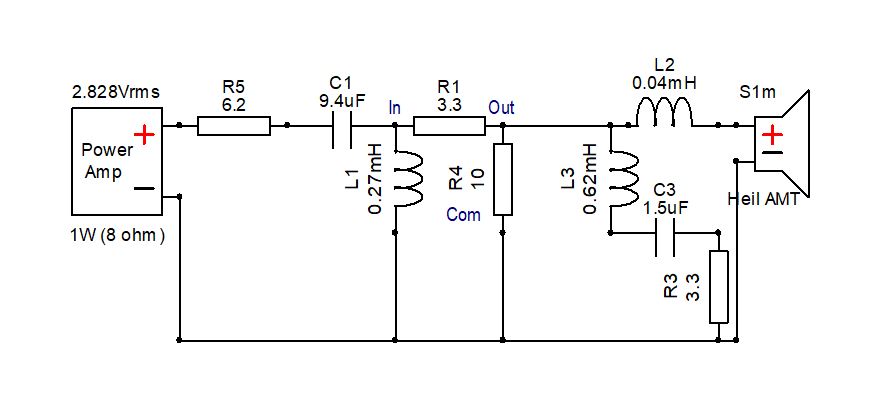
Toni
Sorry, but I really can't help direct you towards a better sounding inductor coil for that position ( L1 ).
I'm curious; What has developed/happened to the "sibilance" problem that was the initial reason for you starting this thread ?
Earl 🙂
Last edited:
Thanks Toni!
Sorry, but I really can't help direct you towards a better sounding inductor coil for that position ( L1 ).
I'm curious; What has developed/happened to the "sibilance" problem that was the initial reason for you starting this thread ?
Earl 🙂
Hi. Sorry for the response time. I am currently happy with the sound of ESS AMT. The "silibance" has been greatly reduced with the RLC cirquit. It has also helped to play with the ESS position. Once the ESS was adjusted, I made a comparison with the original tweeter and its crossover from the original Troels G. project. I like ESS more. For my taste, its timbre is more natural than Berilio's tweeter. But it is a matter of taste.
BR
Toni
Hi. Sorry for the response time. I am currently happy with the sound of ESS AMT. The "silibance" has been greatly reduced with the RLC cirquit. It has also helped to play with the ESS position. Once the ESS was adjusted, I made a comparison with the original tweeter and its crossover from the original Troels G. project. I like ESS more. For my taste, its timbre is more natural than Berilio's tweeter. But it is a matter of taste.
BR
Toni
Toni:
Can you share the final crossover/RLC Eq circuit you use?
Currently I have this filter without L2. My question is about L1. I use in C1 Duelund cast copper. All resistors are Duelund cast graphite. I also use the Duelund bypass Silver foil (0,01uf)
BR
Toni
Hello, in this message you have the information...In any case there are other possible combinations that I have tried and that also work. it depends more on personal taste and the combination with the rest of the team and the room.Thanks to the help of colleagues who have participated in the thread, I have been able to have a good result with the EES
BR
Toni
Hello everyone. I refloat this thread to make an inquiry. I'd like to experiment with my ESS by passing her filter from second to first order (i.e. cancel coil). The three speakers are all in a second order. The mids in inverted phase. With cuts at 200hz and 2200hz.
Are there any counterunits? Could it cause phase problems between the midwofer and the tweeter?
Br
Toni
Are there any counterunits? Could it cause phase problems between the midwofer and the tweeter?
Br
Toni
Thanks to the help received here, I managed to sound the ESS very well (for my taste). However, he had long been following the Arya Airblade with interest. Finally, I have acquired a pair that I have already integrated into my loudspeaquers replacing the ESS. Its integration has been easier than the ESS and I have to say that I loved its sound. For my taste it is a more refined, soft and delicate sound than the ESS, maintaining the character of AMT technology that appeals to me, such as transparency and naturalness. To date the best tweeter I have ever had.
BR
BR
Attachments
- Home
- Loudspeakers
- Multi-Way
- ESS AMT tweeter. Help for correct use
